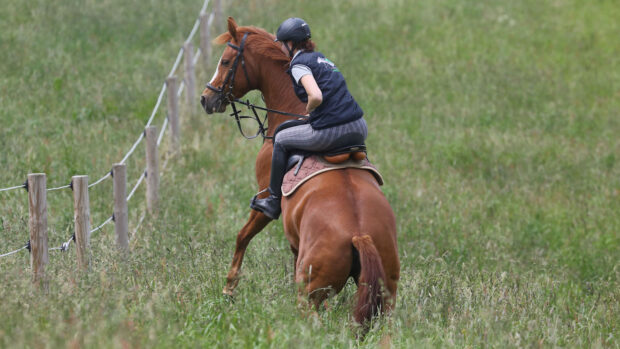The coastguard has issued a safety warning to riders after an “exhausted” horse was rescued from belly-deep mud in a lengthy rescue mission.
Coastguard and fire crews joined search and rescue and Royal National Lifeboat Institution services on Burnham-on-Sea beach on Sunday (14 April) in a major operation to save the trapped horse.
Burnham Coastguard station officer Dave Welland told H&H the call for help came through at about 10am, and that initially two horses were stuck.
“There were three people there, two riders and one other, and at first they tried to get the horses out themselves,” he said. “The first horse came out relatively quickly but the second was belly-deep in the mud.”
Mud rescue technicians from Burnham Coastguard and Weston-Super-Mare Coastguard rescue team were sent to the scene to “assess and retrieve” the humans, then provide safety cover to the large animal rescue teams from the Devon & Somerset and the Avon fire and rescue services.
“Once on scene they incorporated the RNLI tractor into their rescue plan, using rescue strops and a winch, with other plans devised as back-up due to the incoming tide,” a Burnham Coastguard spokesman said.
NB: Please be patient while waiting for the video below to load. If the video fails to load, click here to watch
“After a long intricate process and with great care taken for the horse’s welfare, there was finally steady progress made and the very tired horse inch by inch became free from its sticky confines.
“Once it was freed the poor exhausted horse took a few moments to gather itself then with a burst of energy got to its feet and was reunited with a very relieved owner and went straight into the waiting horsebox.”
The spokesman said it was a “very happy” outcome to what could have been a “very different” situation.
“With so many different agencies on scene it was good to see how each other works in these situations and that we all worked together to achieve a very good result for all concerned,” he added.
Continues below…

Horse rugs help save baby elephants in Zambia
It's not every day a horse blanket saves a life, but that’s exactly what happened to three orphaned baby elephants

‘It shouldn’t take a death’: Riders’ concerns over ‘slippery’ roads
A horse had to be put down after he broke his shoulder in a fall on the road

Subscribe to Horse & Hound magazine today – and enjoy unlimited website access all year round
“We do advise if the tide is out to stay on the firm sand; horses are very heavy and can easily break through the softer surface further down towards the water and with an incoming tide this could have ended in a different way.”
Mr Welland explained that as Burnham-on-Sea is at the mouth of the Severn estuary, and has the second-highest tidal range in the world, large amounts of silt move up and down with the tides, leading to dangerous mud deposits. These tend to be pushed up on to the beach, leading to treacherous conditions.
“There are lots of warning signs up on the beach and we need people to take heed of those warnings,” Mr Welland said. “The mud is always shifting so we can’t map it, so we always advise people to stay up by the high-water mark where the sand’s firmer, although even that isn’t guaranteed not to have soft spots, and walk the area you’re going to ride first.”
For all the latest news analysis, competition reports, interviews, features and much more, don’t miss Horse & Hound magazine, on sale every Thursday.





